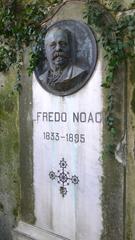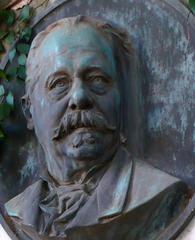
Tomba Alfredo Noack: Visiting Hours, Tickets, and Historical Significance in Genoa
Date: 14/06/2025
Introduction
Set on the hills east of Genoa’s city center, the Monumental Cemetery of Staglieno stands as one of Europe’s grandest open-air museums, blending funerary art, cultural memory, and panoramic views. Within its grounds lies the Tomba Alfredo Noack, a modest yet significant tomb that honors Alfredo Noack (1833–1895), the German-born photographer whose evocative images captured the spirit of Genoa during a time of rapid urban and social change. This guide explores Noack’s legacy, the broader historical and artistic context of Staglieno, and provides up-to-date visitor information, including hours, tickets, accessibility, and travel tips.
Table of Contents
- Introduction
- Historical Context of 19th-Century Genoa and Staglieno Cemetery
- Alfredo Noack: Life and Photographic Legacy
- The Tomba Alfredo Noack: Location, Description, and Symbolism
- Visiting the Monumental Cemetery of Staglieno
- Nearby Attractions and Cultural Highlights
- Frequently Asked Questions (FAQ)
- Visuals, Interactive Media, and Resources
- Conclusion and Recommendations
- References
Historical Context: Genoa’s Transformation and the Genesis of Staglieno
19th-Century Genoa: Urban Modernization and Civic Identity
In the 19th century, Genoa experienced a period of dramatic urban expansion, economic growth, and modernization. Following the Napoleonic era and the city’s annexation to the Kingdom of Sardinia, Genoa’s bourgeois elite spearheaded civic reforms and infrastructure projects, including the development of new public cemeteries. The 1804 Edict of Saint-Cloud, promulgated by Napoleon, mandated the relocation of burials outside city limits, catalyzing the construction of large, landscaped cemeteries as both practical solutions and symbols of civic pride (source; source).
The Creation of Staglieno Cemetery
Conceived in 1835 by architect Carlo Barabino and completed by Giovanni Battista Resasco, the Monumental Cemetery of Staglieno opened in 1851. Its vast grounds—over 33 hectares—feature neoclassical porticoes, a domed Pantheon modeled after Rome’s, and a rich array of funerary sculptures. Staglieno soon became a showcase of Genoa’s artistic ambition, attracting visitors and inspiring writers and artists from across Europe (hermesmagazine.it; official site).
Artistic Masterpieces and Cultural Heritage
Staglieno is renowned for its sculptures and monuments, created by prominent artists such as Leonardo Bistolfi and Giulio Monteverde. The cemetery’s layout combines monumental grandeur with romantic landscaping, and its foreign sections—Protestant, English, and Jewish—reflect Genoa’s cosmopolitan heritage (source).
Alfredo Noack: Life, Career, and Photographic Legacy
Early Life and Move to Genoa
Born in Dresden in 1833, Alfredo Noack was educated in the latest photographic advances of his time. Drawn by Italy’s cultural vibrancy, he settled in Genoa in the 1860s, making it both his home and the primary subject of his work (finestresullarte.info).
Photographic Achievements and Style
Noack quickly established himself as a leading photographer, opening a studio that served a diverse clientele. He excelled in the albumen print process, producing images with remarkable clarity and tonal range. His photographs document Genoa’s medieval streets, bustling port, and architectural landmarks, as well as panoramic cityscapes and daily life. Noack’s work is especially valuable for its documentation of Staglieno’s funerary art, which he captured in a series of detailed studies (alamy.com; visitgenoa.it).
Enduring Influence and Recognition
Noack’s legacy endures through preserved collections and ongoing exhibitions, such as those at the Villa Croce Museum of Contemporary Art. His images remain an essential resource for understanding Genoa’s 19th-century transformation (finestresullarte.info).
The Tomba Alfredo Noack: Location, Description, and Symbolism
Locating the Tomb
Noack’s tomb is set within the Protestant section of Staglieno, easily accessed from the main entrance at Piazzale Resasco (16137 Genoa). Maps are available at the information kiosk, and guided tours frequently include the site (Bimbe in Viaggio; Mapcarta).
Description and Artistic Context
In contrast to the ornate marble mausoleums of the Catholic sections, the Tomba Alfredo Noack is a simple stone slab inscribed with his name and dates—a reflection of Protestant funerary traditions emphasizing humility and personal remembrance. The tomb is surrounded by cypress trees and offers a tranquil setting for reflection (Bimbe in Viaggio).
Symbolic Value
While understated, the tomb’s context within Staglieno’s rich artistic landscape highlights the diversity of Genoa’s 19th-century society and the enduring value of Noack’s photographic legacy. Visitors often leave flowers or photographs, underscoring his lasting influence (Discover Genoa).
Visiting the Monumental Cemetery of Staglieno
Hours, Tickets, and Accessibility
- Opening Hours: Daily, 7:30 AM – 5:00 PM (last entry 4:30 PM). Hours may change seasonally or on holidays; check the official website before visiting.
- Admission: Free. Guided tours (in multiple languages) require advance booking and a modest fee (usually around €5) (Where’s Ben Been).
- Accessibility: Main paths are paved, but some routes are hilly or uneven. Wheelchair users should consult staff for accessible routes and assistance.
Guided Tours and Photography
- Guided Tours: Tours highlight Staglieno’s history, art, and notable graves, including Noack’s. Book via the official site, local tourist offices, or on-site.
- Photography: Permitted throughout the cemetery. Respectful, non-intrusive photography is encouraged, especially given Staglieno’s artistic heritage.
Directions and Visitor Tips
- Getting There: From Genova Brignole station, take bus lines 34, 48, or 480 to the cemetery entrance. Limited parking is available nearby (Italy Heaven).
- Facilities: Restrooms are located near the entrance; there are no cafés or shops on-site—bring water and snacks.
- Dress Code: Wear respectful attire (no beachwear, sleeveless tops, or shorts).
- Visitor Tips:
- Wear comfortable walking shoes.
- Plan for at least two hours to explore.
- Visit in spring or early autumn for mild weather and fewer crowds (When to Go Weather).
- Download the Audiala app for audio guides and interactive maps.
Nearby Attractions and Cultural Highlights
Combine your visit to Staglieno with other Genoa landmarks:
- Palazzo Ducale: A historic palace and cultural center.
- Old Port (Porto Antico): Revitalized waterfront with museums and dining.
- Cattedrale di San Lorenzo: Genoa’s medieval cathedral.
- Museo di Palazzo Reale: A treasure trove of Genoese art and history (Visit Genoa).
Frequently Asked Questions (FAQ)
Q: What are the visiting hours?
A: 7:30 AM to 5:00 PM daily (last entry 4:30 PM; hours may vary—check the official site).
Q: Is there an entrance fee?
A: No. Admission is free; fees apply only to guided tours.
Q: Are guided tours available in English?
A: Yes, but advance booking is recommended.
Q: Is the cemetery accessible for wheelchairs?
A: Major paths are accessible, but some areas are hilly; ask staff for assistance.
Q: How can I reach Staglieno from the city center?
A: Take bus lines 34, 48, or 480 from Genova Brignole station.
Q: Can I take photographs?
A: Yes, but be respectful and avoid flash or tripods.
Q: Are there facilities on-site?
A: Restrooms near the entrance; no cafés or shops inside.
Visuals and Interactive Resources
- Explore virtual tours and galleries featuring Staglieno’s sculptures and Protestant section.
- Use interactive maps on the Audiala app or Genoa’s official tourism platforms.
- Alt text for images: “Tomba Alfredo Noack at Monumental Cemetery of Staglieno, Genoa.”
Conclusion and Recommendations
A visit to the Tomba Alfredo Noack in Staglieno is a journey through Genoa’s rich artistic, historical, and multicultural heritage. The cemetery’s serene beauty, monumental sculptures, and the quiet legacy of Alfredo Noack invite reflection on memory, art, and identity. With free admission, accessible hours, and comprehensive guided tours, Staglieno is a must-see for anyone interested in the history and culture of Genoa.
Enhance your experience by downloading the Audiala app for audio guides and interactive content, and stay updated through official channels for special events and exhibitions. Combine your visit with nearby historical sites to fully appreciate Genoa’s vibrant past and present.
References
- Monumental Cemetery of Staglieno, Comune di Genova
- Staglieno Cemetery Genoa: Visiting Hours, Tickets & Historical Guide, Hermes Magazine
- Visiting the Monumental Cemetery of Staglieno: Discover Alfredo Noack’s Legacy, Finestre sull’Arte
- Tomba Alfredo Noack Visiting Hours, Tickets & Guide to Genoa’s Historic Cemetery, Italy Heaven
- Visiting the Tomba Alfredo Noack: Hours, Tickets, and History at Genoa’s Staglieno Cemetery, Discover Genoa
- Alfredo Noack photographic works, Musei di Genova
- Bimbe in Viaggio: Staglieno Cemetery
- Mapcarta: Tomba Alfredo Noack
- Where’s Ben Been: Visiting Staglieno
- Visit Genoa: Official Tourism Portal
- When to Go Weather: Genoa in June
- BillionGraves Blog: Italian Cemetery Statues




































































































